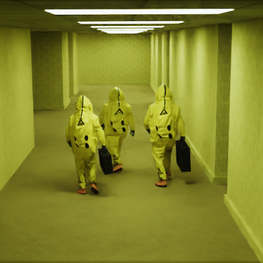
Three researchers traveling through KV31.
Project KV31 was a dimensional engineering program developed by the ASYNC Foundation in the 1980s for the purpose of creating unlimited storage and residential space. The project was funded by the U.S. government, specifically the Department of Energy, and involved the use of a highly experimental Low-Proximity Magnetic Distortion System, also known as LPMDS for short. It was based at the _____________ in California. ASYNC employees also referred to the project as "The Machine," "The Door," "The Back Rooms," "The Complex," and "Hallways."
History[]
Prototype[]
The very first tests of a prototype magnetic distortion system were conducted in 1982 at the Oak Ridge National Laboratory under the supervision of Philip Heymann. In one experiment, highly accelerated particles were shot at a small spherical test article in which formed a massive yellow glow along the central and outer rings of the machine before quickly fading.
KV31 Press conference[]
A full-scale version of the Low-Proximity Magnetic Distortion System was completed by the late 1980s. In an ApriI 1988 press conference, ASYNC Vice-Director Ivan Beck was optimistic, stating "this program, if granted sufficient backing from the United States government will offer a solution to all current and future storage and residential needs, and save billions of dollars on property construction and management."
The Third Test[]
An extensive testing campaign followed, with the third test of the technology completed on July 2, 1988.
First Contact[]
The program was partly successful on October 17, 1989, when, during the sixth test of the Project KV31 hardware, a vast complex of rooms appeared beyond the Low-Proximity Magnetic Distortion System threshold. The project's goal from that point on appeared to be the documentation and exploration of the new space, with a plan to make it safe for future use.
Unbeknownst to ASYNC, not only did the final test cause a significant earthquake in the local area [collateral.mov], but the complex also presented a significant danger to ASYNC employees and members of the general public alike, with missing persons cases rising rapidly after the 1989 test [Missing Persons]; the fabric of reality had seemingly been damaged and it became possible to fall into the complex through solid ground [Found Footage].
Missing Persons[]
The first body was discovered in the complex on February 3, 1990, during a research expedition.